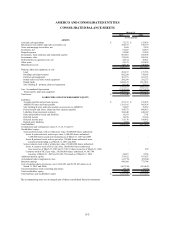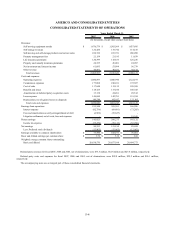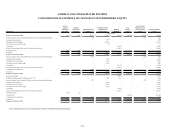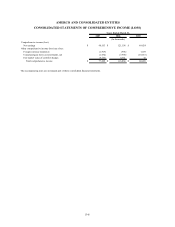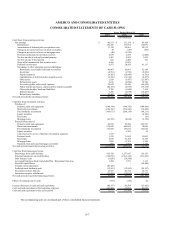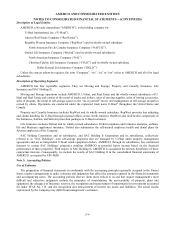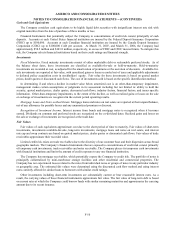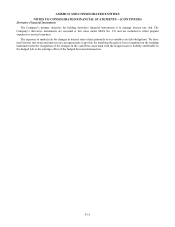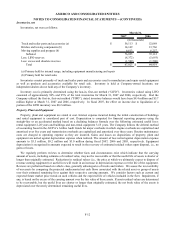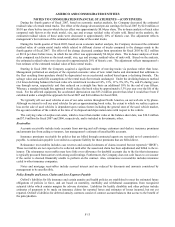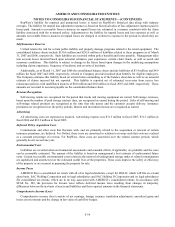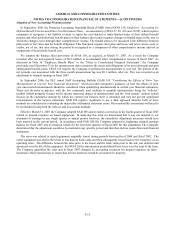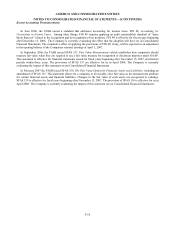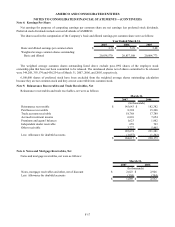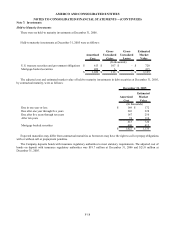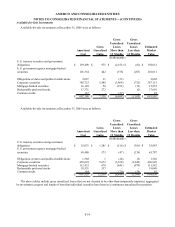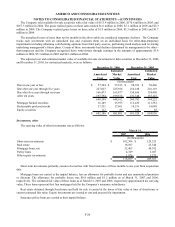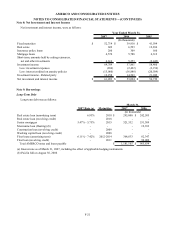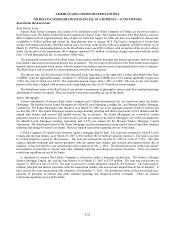U-Haul 2007 Annual Report Download - page 78
Download and view the complete annual report
Please find page 78 of the 2007 U-Haul annual report below. You can navigate through the pages in the report by either clicking on the pages listed below, or by using the keyword search tool below to find specific information within the annual report.AMERCO AND CONSOLIDATED ENTITIES
NOTES TO CONSOLIDATED FINANCIAL STATEMENTS -- (CONTINUED)
During the fourth quarter of fiscal 2007, based on economic market analysis, the Company decreased the estimated
residual value of certain rental trucks. The effect of the change decreased pre-tax earnings for fiscal 2007 by $2.0 million or
$0.10 per share before taxes in which the tax effect was approximately $0.04 per share. The in-house analysis of truck sales
compared such factors as the truck model, size, age and average residual value of units sold. Based on the analysis, the
estimated residual values of these units were decreased to approximately 20% of historic cost. The adjustment reflects
management’ s best estimate of the estimated residual value of the rental trucks.
During the fourth quarter of fiscal 2005, based on an economic market analysis, the Company decreased the estimated
residual value of certain rental trucks which related to different classes of trucks compared to the changes made in the
fourth quarter of fiscal 2007. The effect of the change decreased earnings from operations for fiscal 2005 by $2.1 million
or $0.10 per share before taxes, in which the tax effect was approximately $0.04 per share. The in-house analysis of truck
sales compared such factors as the truck model, size, age and average residual value of units sold. Based on the analysis,
the estimated residual values were decreased to approximately 20% of historic cost. The adjustment reflects management’ s
best estimate of the estimated residual value of these rental trucks.
Starting in fiscal 2006 the Company acquired a significant number of moving trucks via purchase rather than lease.
Management performed an analysis of the expected economic value of new rental trucks and determined that additions to
the fleet resulting from purchase should be depreciated on an accelerated method based upon a declining formula. The
salvage value and useful life assumptions of the rental truck fleet remain unchanged. Under the declining balances method
(2.4 times declining balance) the book value of a rental truck is reduced 16%, 13%, 11%, 9%, 8%, 7%, and 6% during years
one through seven, respectively and then reduced on a straight line basis an additional 10% by the end of year fifteen.
Whereas, a standard straight line approach would reduce the book value by approximately 5.3% per year over the life of the
truck. For the affected equipment, the accelerated depreciation was $33.2 million greater than what it would have been if
calculated under a straight line approach for fiscal 2007 and $4.0 million for fiscal 2006.
We typically sell our used vehicles at one of our sales centers throughout North America, on our web site or by phone.
Although we intend to sell our used vehicles for prices approximating book value, the extent to which we realize a gain or
loss on the sale of used vehicles is dependent upon various factors including the general state of the used vehicle market,
the age and condition of the vehicle at the time of its disposal and depreciation rates with respect to the vehicle.
The carrying value of surplus real estate, which is lower than market value at the balance sheet date, was $10.8 million
and $7.9 million for fiscal 2007 and 2006, respectively, and is included in Investments, other.
Receivables
Accounts receivable include trade accounts from moving and self-storage customers and dealers, insurance premiums
and amounts due from ceding re-insurers, less management’ s estimate of uncollectible accounts.
Insurance premiums receivable for policies that are billed through contracted agents are recorded net of commission’ s
payable. A commission payable is recorded as a separate liability for those premiums that are billed direct.
Reinsurance recoverables includes case reserves and actuarial estimates of claims incurred but not reported (“IBNR”).
These receivables are not expected to be collected until after the associated claim has been adjudicated and billed to the re-
insurer. The reinsurance recoverables may have little or no allowance for doubtful accounts due to the fact that reinsurance
is typically procured from carriers with strong credit ratings. Furthermore, the Company does not cede losses to a re-insurer
if the carrier is deemed financially unable to perform on the contract. Also, reinsurance recoverables includes insurance
ceded to other insurance companies.
Notes and mortgage receivables include accrued interest and are reduced by discounts and amounts considered by
management to be uncollectible.
Policy Benefits and Losses, Claims and Loss Expenses Payable
Oxford’ s liabilities for life insurance and certain annuity and health policies are established to meet the estimated future
obligations of policies in force, and are based on mortality, morbidity and withdrawal assumptions from recognized
actuarial tables which contain margins for adverse deviation. Liabilities for health, disability and other policies include
estimates of payments to be made on insurance claims for reported losses and estimates of losses incurred, but not yet
reported. Oxford’ s liabilities for deferred annuity contracts consist of contract account balances that accrue to the benefit of
the policyholders.
F-13


